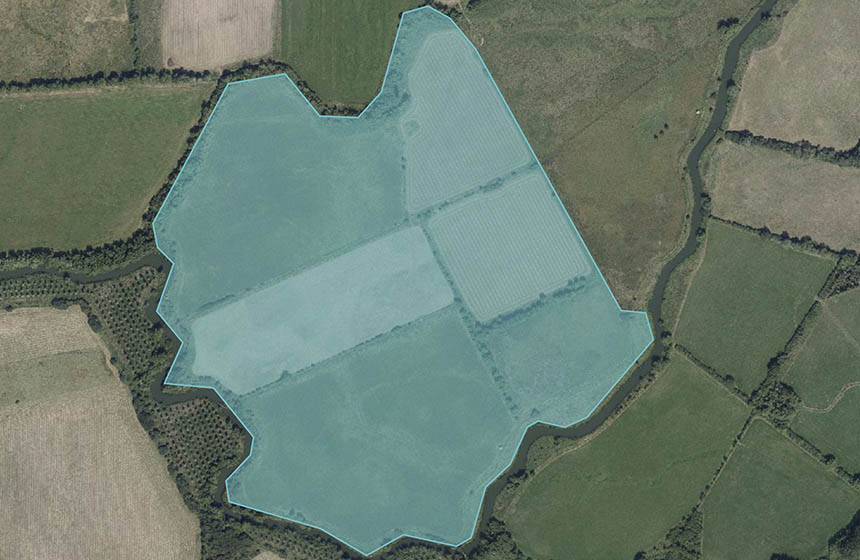Chimney Meadows floodplain restoration
Wildflower meadows and wetlands are being restored at Chimney Meadows Nature Reserve to increase biodiversity, provide flood protection and improve water quality. Innovative financing enables the uncertain outcomes of nature-led restoration approaches to be assessed, and a targeted approach is used to monitor outcomes with limited resources. Rapid ecosystem assessment tools have been used to demonstrate the multiple benefits of restoration.
Nature-based intervention:
The site was restored from a commercial farm into wildflower meadows, hedgerows, and wetlands. Traditional farming methods are used to manage the meadows. New scrapes and ponds were created to facilitate wading birds and amphibians, and a fish bypass channel was installed. The nature reserve is part of a larger Upper Thames Living Landscape area which connects 2,760 hectares of riverside habitats.
Overview of context and outcomes:
Chimney Meadows National Nature Reserve has been managed by Berkshire, Buckinghamshire, and Oxfordshire Trust (BBOWT) since 1999. In 2003, BBOWT purchased an adjacent plot of intensively managed farmland, aiming to restore wetland features and extend floodplain hay meadows. A further acquisition of Duxford Old River in 2017 provides BBOWT with a total of 307 hectares of land managed as the Chimney Meadows Nature Reserve.
Case effectiveness on
Climate change
Following the regrowth of grasses and wildflowers and recovery of degraded soil, it is estimated that the reserve has changed from a net source of carbon emissions to a sink (1). The site’s 78.7 hectares of semi-natural grassland is estimated to result in a net sequestration of around 460 tonnes of CO2 equivalent per year (2).
Soil carbon and greenhouse gas emissions are being assessed in partnership with the Floodplain Meadows Partnership and Bangor University. It is thought that the very deep roots of floodplain plants (deeper than tree roots) could enhance soil carbon storage, and that the tussocky structure helps to trap sediment when the river floods, building up soil depth. Full results are not yet available.
The reserve is part of a natural floodplain, and during flood events it stores water from the River Thames, thus reducing downstream flooding. Compared to previous land management, the increased flood mitigation from the restored habitats on the main reserve is estimated to provide net monetary benefits worth an extra £250 per hectare (1). The new project at Duxford Old River is intended to increase flood storage further by breaking through flood embankments to improve connectivity between the river and its floodplain, and adding structures to slow the flow of water and retain water for longer (3). In addition, creation of new wetland habitats is intended to provide resilience to climate change impacts for wildlife such as wetland birds and water voles (3).
Ecosystem health
Ecological effect: PositivePrior to restoration, the river had poor ecological status because weirs and fords were acting as barriers to fish movement. To address this, a multipurpose 450 m naturalised bypass channel was created, increasing opportunities for fish to move past the barriers and spawn. Improvements enabling fish passage were also made at two fords, and access was facilitated to an additional 30 km of river habitat (3). The new channel also improves the connection between the river and its floodplain, thus improving water quality. In addition, the project aims to restore native wet woodland species. Invasive Himalayan balsam is controlled to support growth of native species of flora and fauna (3)
Socioeconomic outcomes
Chimney Meadows Nature Reserve provides cultural and health benefits to visitors. Benefits for recreation, aesthetic value and health were projected to be more than six times greater as a conservation site compared to as a commercial agricultural site, with total net benefits to society being estimated as four times greater.
Governance
Local participation in Governance: PassiveBBOWT manages Chimney Meadows Nature Reserve and consults residents of neighbouring areas on their land management preferences (3). They engage with local people by supporting occasional school trips and adult learning. As part of the Living Landscapes initiative, they facilitate a local Farmer Cluster, give talks to landowners and provide practical support for restoration initiatives such as providing advice and supplying ‘green hay’ as a seed source for meadow creation (4).
Finance
The project is supported by the Heritage Lottery Fund and the Biodiversity Action Fund. The European Agricultural Fund for Rural Development provided funds for improvements to fish passage, water control structures, scrapes and general wetland restoration works via a Water Environment Grant.
However, further funding is needed to cover the cost of maintaining the site, including through conservation grazing. Innovative funding methods are being developed following the Wildlife Trusts Habitat Banking project (a partnership between BBOWT, Cheshire, Warwickshire and Surrey Wildlife Trusts, and Finance Earth). This involves the creation and enhancement of habitats with the intention of selling Biodiversity Net Gain (BNG) units to developers who wish to offset habitat losses elsewhere. BBOWT initiated the project with Finance Earth, Bidwells (land agents) and the Trust for Oxfordshire’s Environment (TOE) to design and implement the habitat bank (6).
As BBOWT plan to adopt a minimal intervention approach to habitat restoration, they cannot predict exactly what habitats will appear on the site and what their condition will be; much of the restored site will consist of floodplain wetland mosaic and mixed scrub. BBOWT have therefore taken a cautious approach to the outcomes predicted through the DEFRA BNG Metric, retaining the option to re-baseline the site in subsequent years to evaluate incremental opportunities for future habitat enhancement on the site. To reflect the biodiversity value of scattered scrub, they treat it as an indicative ‘block’ that equates to the approximate total expected area of scrub in the habitat mosaics.
BBOWT sold a first batch of BNG units from the site to TOE in early 2023, but with the mandatory BNG regulations coming in to effect in February 2024, Duxford is being registered with Natural England as a habitat bank to enable the sale of biodiversity units directly to developers. This has required a revised Statutory metric baseline, a supporting Habitat Management and Monitoring Plan and a S106 agreement to be confirmed with the Vale of White Horse District Council. Future sales of biodiversity units are expected to generate income in excess of £2m, sufficient to offset the operational management of Duxford for the next 30 years.
Monitoring and evaluation
As a charity with limited resources, ongoing monitoring focuses mainly on the key elements of the habitat features needed to support target species, as this is easier than monitoring the species themselves. For example, to support bats, they aim to maintain rough grassland to encourage the insect populations that bats eat; this is assessed in terms of characteristics such as sward height and flowering plant diversity. Similarly, for curlews, the key feature is the softness of the ground, as that enables curlews to probe for their food. As much of the habitat surveying is carried out by volunteers, it is carried out at certain times of year when there are indicator species that are relatively easy to identify (e.g. cowslip), following a clear, quick and simple methodology (4).
This habitat-based monitoring is complemented with regular surveys carried out by volunteers, such as transects to monitor breeding birds, using standardised procedures. These are targeted at species where it is important to monitor change. For example, otters are no longer surveyed because they are known to be established on the site. Long term monitoring is being funded partly through sale of BNG units.
To complement the biodiversity monitoring, in 2017, BBOWT undertook a quantitative assessment of ecosystem services provided under a potential conservation management scenario compared to a ‘business-as-usual’ scenario of intensive agricultural management. The rapid ecosystem services assessment estimated costs using business plans and benefits through a benefits transfer approach. The methods, assumptions and limitations are stated in the 2017 Chimney Meadows Ecosystem Services Assessment (2).
More recently, BBOWT employed consultants to assess the outcomes of the habitat restoration using the Environmental Benefits from Nature Tool. This was developed by Natural England to work alongside the Biodiversity Metric, to assess the changes in 18 ecosystem services arising from land-use change (5). They have used the outputs of the tool for communication of the wider benefits of the scheme to stakeholders and investors, to demonstrate expected moderate benefits for water supply, flood regulation, erosion protection, carbon storage, air quality regulation, cooling and shading, and interaction with nature, and large increases in water quality regulation, pollination, pest control, aesthetic value, and sense of place (4, 6).
Trade-offs and limitations
The initial conversion of the site from intensive farmland to low density grazing reduced the annual food production capacity. The total monetary value of benefits accrued from food production were around 1.8 times more when the land was managed as a commercial agricultural farm compared to the future state of being restored for conservation (2). However, overall, the net benefit to society is £7.0m higher with management of landscape for conservation and flood protection compared to commercial agricultural use.
There is a trade-off between access to the land and biodiversity outcomes. Access to the Duxford meadow site is restricted because it would pose risks to ground-nesting birds. However this has been mitigated to some extent by providing a bird hide on the other side of the river, in the main Chimney Meadows reserve, where visitors can view the birds on the reserve (4).
Another trade-off arises between carbon sequestration and biodiversity, as maintaining the open grassland and wetland habitats for biodiversity requires removal of encroaching trees and scrub (4). However, monitoring of soil carbon indicates that increased flower species diversity leads to greater carbon storage.
References
- Berkshire Buckinghamshire & Oxfordshire Wildlife Trust. N.d. A nature based solutions case study: Chimney Meadows. https://www.bbowt.org.uk/chimney-meadows-nature-based-solutions-case-study
- Hölzinger & Haysom. 2017. Chimney Meadows Ecosystem Services Assessment. https://www.bbowt.org.uk/sites/default/files/2018-02/Chimney%20Meadows%20Ecosystem%20Services%20Assessment%202017%20FINAL_0.pdf
- Berkshire Buckinghamshire & Oxfordshire Wildlife Trust. N.d. Chimney meadows wetland restoration project. https://www.bbowt.org.uk/chimney-meadows-wetland-restoration-and-fish-passage-project
- Personal communication with BBOWT staff, December 2022.
- Natural England. 2021. Environmental Benefits from Nature Tool. https://publications.naturalengland.org.uk/publication/6414097026646016
- UK Green Building Council. N.d. Duxford Old River Floodplain Restoration Project & Habitat Bank. https://ukgbc.org/resources/duxford-old-river-floodplain-restoration-project-habitat-bank/
- Oxfordshire Local Nature Partnership. N.d. Financing nature-based solutions in Oxfordshire A strategic plan to catalyse a framework of natural capital investment. https://democratic.whitehorsedc.gov.uk/documents/s58527/Oxfordshire%20Nature%20Finance%20Strategy%20v5.pdf
- BBOWT. N.d. Duxford Habitat Bank Biodiversity Net Gain. https://www.bbowt.org.uk/what-we-do/future-nature-wtc/biodiversity-net-gain/duxford-habitat-bank

Intervention type
- Created habitats
- Management
- Restoration
Ecosystem type
- Temperate forests
- Temperate grasslands
- Wetlands
Climate change impacts addressed
- Freshwater flooding
Instigators
- Local NGO or CBO (eg. indigenous)
Societal challenges
- Biodiversity conservation
- Climate change adaptation
- Climate change mitigation
- Health
Outcomes
- Food security: Negative
- Water security: Not reported
- Health: Positive
- Local economics: Not reported
- Livelihoods/goods/basic needs: Not reported
- Energy security: Not reported
- Disaster risk reduction: Positive
- Rights/empowerment/equality: Not reported
- Recreation: Positive
- Education: Not reported
- Conflict and security: Negative
- No. developmental outcomes reported: 5
Resources
Read resource 1Literature info
- Grey literature




